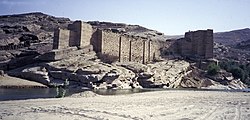British domain, Colony of Aden and Aden protectorate
British interests in the area which would later become South Yemen, began to grow when in 1839, British East India Company forces captured the port of Aden, to provide a coaling station for ships en route to India. [8] The colony, known as the Aden Settlement, gained much political and strategic importance after the opening of the Suez Canal in 1869. [9]
Aden was ruled as part of British India until 1937, when the city of Aden became the Colony of Aden, a crown colony in its own right. The Aden hinterland and Hadhramaut to the east formed the remainder of what would become South Yemen and was not administered directly by Aden but were tied to Britain by treaties of protection. Starting in the latter decades of the 19th century and continuing into the 20th century, Britain signed agreements with local rulers of traditional polities that, together, became known as the Aden Protectorate. The area was divided into numerous sultanates, emirates, and sheikhdoms, and was divided for administrative purposes into the East Aden Protectorate and the West Aden Protectorate. The eastern protectorate consisted of the three Hadhramaut states (Qu'aiti State of Shihr and Mukalla, Kathiri State of Seiyun, Mahra Sultanate of Qishn and Socotra) with the remaining states comprising the west. Economic development was largely centred in Aden, and while the city flourished partly due to the discovery of crude oil on the Arabian Peninsula in the 1930s, the states of the Aden Protectorate stagnated.
Encouraged by the rhetoric of President Nasser of Egypt against British colonial rule in the Middle East, pressure for the British to leave grew. Following Nasser's creation of the United Arab Republic, attempts to incorporate Yemen in turn threatened Aden and the Protectorate. To counter this, the British attempted to unite the various states under its protection and, on 11 February 1959, six of the West Aden Protectorate states formed the Federation of Arab Emirates of the South to which nine other states were subsequently added. During the 1960s, the British sought to incorporate all of the Aden Protectorate territories into the Federation. On 18 January 1963, the Colony of Aden was incorporated against the wishes of much of the city's populace as the State of Aden and the Federation was renamed the Federation of South Arabia. Several more states subsequently joined the Federation and the remaining states that declined to join, mainly in Hadhramaut, formed the Protectorate of South Arabia.
In 1963, fighting between Egyptian forces and British-led Saudi-financed guerrillas in the Yemen Arab Republic spread to South Arabia with the formation of the National Liberation Front (NLF), who hoped to force the British out of South Arabia. Hostilities started with a grenade attack by the NLF against the British High Commissioner on 10 December 1963, killing one person and injuring fifty, and a state of emergency was declared, becoming known as the Aden Emergency. [10]
In 1964, the new British government under Harold Wilson announced their intention to hand over power to the Federation of South Arabia in 1968, but that the British military would remain. There were around 280 guerrilla attacks in 1964, and over 500 in 1965. In 1966, the British Government announced that all British forces would be withdrawn at independence. In response, the security situation deteriorated with the creation of the socialist Front for the Liberation of Occupied South Yemen (FLOSY) which started to attack the NLF in a bid for power, as well as attacking the British. [10]
In January 1967, there were mass riots by NLF and FLOSY supporters in the old Arab quarter of Aden town, which continued until mid February, despite the intervention of British troops. During the period there were many attacks on the troops, and an Aden Airways Douglas DC-3 plane was destroyed in the air with no survivors. At the same time, the members of FLOSY and the NLF were also killing each other in large numbers. [11]
The temporary closure of the Suez Canal in 1967 effectively negated the last reason that British had kept hold of the colonies in Yemen, and, in the face of uncontrollable violence, they began to withdraw. [12] [13]
On 20 June 1967, there was a mutiny in the Federation of South Arabia Army, which also spread to the police. Order was restored by the British, mainly due to the efforts of the 1st Battalion Argyll and Sutherland Highlanders, under the command of Lt-Col. Colin Mitchell. [10]
People's Democratic Republic of Yemen (1967–1990)
The British pulled out on 30 November 1967, leaving Aden under NLF control. The Royal Marines, who had been the first British troops to occupy Aden in 1839, were the last to leave. [14] The Federation of South Arabia collapsed, and Southern Yemen became independent as the People's Republic of South Yemen. The NLF, with the support of the army, attained total control of the new state after defeating the FLOSY and the states of the former Federation in a drawn out campaign of terror. [15] [16]
In June 1969, a Marxist wing of the NLF gained power and changed the country's name to the People's Democratic Republic of Yemen (PDRY) on 1 December 1970. In the PDRY, all political parties were amalgamated into the Yemeni Socialist Party (YSP), which became the only legal party. The PDRY established close ties with the Soviet Union, the People's Republic of China, Cuba, and Palestine. [17] [18]
These major communist powers assisted in the building of the PDRY's armed forces. Strong support from Moscow resulted in the Soviet Navy gaining access to naval facilities in South Yemen. [19]





